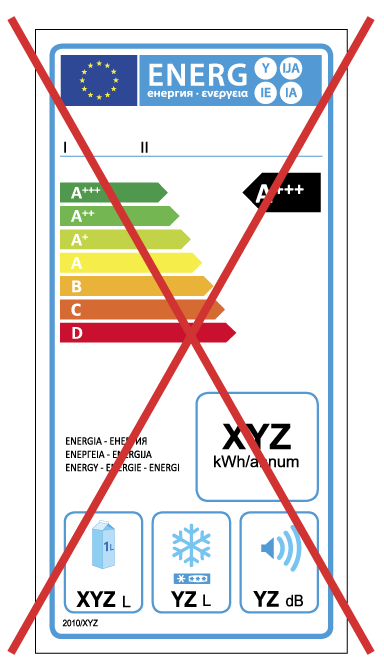Energy Labeling for Water Dispensers, Does it Exist?
The short answer to this question is No.
We are often asked what energy class our water dispensers have. The question is reasonable in every way! Since the EU introduced regulations for energy declarations and Eco-design over 25 years ago, consumers have become accustomed to recognizing the labels and using the information when choosing new equipment for homes and offices.
What many don’t know is which products need to be labeled and on what grounds. This can, among other things, cause problems when consumer labels sometimes appear as requirements for equipment being procured for use in contexts unrelated to private consumers. Additionally, there are sometimes labeling requirements for products that are not covered under the EU’s regulations on labeling requirements, such as water dispensers.
Which Products Should Be Labeled?
In most cases, it’s crystal clear! According to the European Commission’s requirements for Eco-design and Energy Labeling (regulations 2009/125 and 2017/1369), several product groups are listed under these requirements. Each product group is also divided into two subgroups, which are requirements for Eco-design and Energy Declaration, respectively.
These product groups are listed here (and here) and each has its own so-called Harmonized Standard, which details the conditions and testing procedures for each product group and regulation.
It is important to understand that product groups have different requirements for Eco-design and Energy Labeling. Furthermore, the design requirement for Energy Labeling was updated according to an article published on February 16, 2021 (the new label should primarily be updated for household products and is recognized by the QR code in the upper right corner).
Products affected by the new energy labeling include dishwashers, refrigerators, freezers, washing machines, combined washing machines, tumble dryers, lamps, wine coolers, monitors, and TVs. EU countries have decided that energy labeling with the scale A+++ to G will be changed and replaced with the scale A to G. The arrow colors will remain the same as they are today.
Among the product groups for consumer products are also, for example, computers, dishwashers, ovens, fans, A/C systems, and other household equipment. Among product groups, there are also products for commercial use, such as water pumps, refrigerators, ventilation and cooling systems, commercial kitchen refrigerators, vending machines, and a separate group for general home electronics with standby functions.
 Which Group Do Water Dispensers Belong To?
Which Group Do Water Dispensers Belong To?
For water coolers and water dispensers, there is no harmonizing standard, and therefore no testing method can currently be applied to the product (as of June 2021).
This applies to both the requirements for Eco-design and Energy Labeling. Therefore, procurement requirements for Energy Labeling for water machines are invalid and should be met with the counter-question of “Energy Labeling according to which Harmonized Standard?”
We are continuously following up on whether new information arises that would bring water dispensers under an existing standard, but currently, this is not the case.
For example, we have looked into whether the product group Cooling Equipment is relevant, but for this group, there is no Energy Labeling requirement, only for Eco-design, which also applies to household equipment with standby mode and water pumps.
For condensing units, it refers to refrigerators and freezers for professional use, quick-chill cabinets, condenser units, and process coolers. However, the group is exempt from Energy Labeling and thus only has requirements for Eco-design. For cooling systems, it refers to comfort cooling and air conditioning, which is not applicable.
For the respective Harmonized standards for the product group “cooling/freezing products for household use” and the product group “cooling/freezing products with direct sales function,” the protocol is adapted for measuring equipment intended for cooling packaged products/food, not for cooling circulating liquids in a closed loop.
Other Types of Labeling
Previously, EVA (European Vending Association) had its own standard called EMP (Energy Measurement Protocol) that, in its version 3.1a, referred to testing methods for beverage dispensers for hot and hot/cold water. This protocol has now been withdrawn in favor of the EU’s own Harmonized Standard EN 50597:2018, which will come into effect in March 2021.
The labeling for “Refrigerated Vending Machines” had a scale from A++ to G, while the official EU scale replacing it uses a scale from A to G. The scale from EMP was never allowed to be used as consumer guidance in the form of labeling directly on the machine.
In EN 50597, specific exceptions for the standard are listed, including the statement “– beverage machines that dispense hot and/or cold drinks in cups,” which includes water dispensers and coffee machines. This means that with the withdrawal of EMP 3.1a, it is now not permitted to label coffee machines with energy labels.
Note that in EN 50597, energy declarations are currently not allowed for vending machines with a class higher than C. Version EMP 3.1b only refers to beverage dispensers for hot and hot/cold drinks and is still relevant as a reference, but not as a legal requirement.
Energy Labeling Requirements in Procurement Documents
I’ve been asked for Energy Labeling in a procurement document. What should I do?
There is currently a tangled situation regarding information on Energy Declarations, but it is clear that a procuring entity cannot set requirements that contradict an EU regulation. So, what happens if Energy Labeling is required for a water dispenser in the procurement process? The short answer is that Energy Declaration cannot be required for water dispensers (water coolers).
This applies if an Energy Declaration is requested according to:
-
EN 50597 (European Union, Energy Labeling Regulation, Standard EN 50597:2018)
This is the measurement standard according to the EU’s official labeling “Energy Labeling Regulation” (Regulation EU2017/1369). It primarily applies to cooling equipment/cabinets intended to cool and make individually packaged goods available and is applicable to vending and vending machines in 6 subcategories:
-
Vending machines with a closed front, for cooling stacked cans and bottles
-
Vending machines with a door for cans, bottles, candy, and snacks
-
Vending machines with a door for chilled food
-
Vending machines with different temperature zones
-
Vending machines for non-chilled snacks and meals
-
Combination machines that consist of two different machine categories
The following machine types are completely exempt:
-
Beverage machines for hot and/or cold drinks in cups
-
Machines with food warming functions
-
Vending machines that operate at temperatures below 0°C
-
Combination machines of the categories described above
Products not listed under the standard also have no labeling requirements (e.g., beverage dispensers intended for cups ≈ dosed and freely flowing dispensing, as opposed to packaged drinks). Also, note that from the introduction of 50597:2018, as of March 1, 2021, results for vending machines above class C are not allowed.
A procurement cannot require Energy Labeling for water dispensers according to EN50597.
-
EVA EMP v3.1a (European Vending Association, Energy Measuring Protocol)
Protokollet avsåg ”Refrigeratet Vending machines” har utgått 2019 och helt ersatts av EN 50597. De täcker inte upp för exakt samma typer av produkter, men det görs tydligt från EVA’s sida att allt material som hänvisar till EMP 3.1a måste tas bort från försäljningsledet. Det får inte förekomma i sammanhang såsom hemsidor, PDF, printade lappar, marknadsföringsmaterial, manualer etc.
Märkningen hade en mätskala från A++ till G, medans den, från EU, ersättande officiella skalan enligt 50597 har en mätskala från A-G vilket också riskerar att skapa missförstånd. Skalan från EMP har aldrig tillåtits användas som konsumentvägledande i form av märkning direkt på maskinen.
Märkningen får endast användas i B2B och inte som konsumentmärkning fäst på maskinen eller på annat sätt, för konsumenter, vägledande märkning på apparater. Upphandlingar som hänvisar till denna standard ska upplysas om att den inte längre är tillåten att användas som referens då den är motsägande den gällande standarden EN 50597.
En upphandling kan inte kräva Energimärkning för vattenautomater enligt EVA EMP 3.1a
EVA EMP v3.1b (European Vending Association, Energy Measuring Protocol)
Protokollet gäller för ”Vending & Dispensing Machines” samt ”Hot and Hot & Cold Drink Machines”. Protokollet är alltså utfört för att enbart mäta mot maskiner med primärt värmande funktion men är fortsatt gällande som energireferens för dryckesautomater för heta drycker.
EMP är inte underställd en förordning eller lagkrav och kan endast ses som rekommenderande. Vidare får utformningen av mätresultatet under inga omständigheter göras så att de riskerar att blandas ihop med EU’s energideklarationer och har heller aldrig tillåtits att göra så.
En upphandling kan inte kräva Energimärkning för vattenautomater EVA EMP 3.1b
Källor:
https://ec.europa.eu/growth/single-market/european-standards/harmonised-standards/ecodesign_en
https://www.vending-europe.eu/new-energy-label-brings-big-changes-for-refrigerated-vending-machines/

